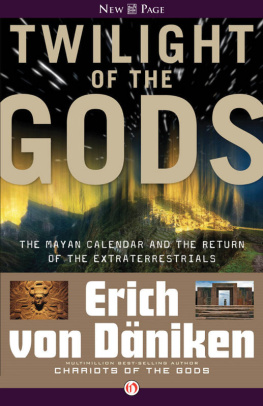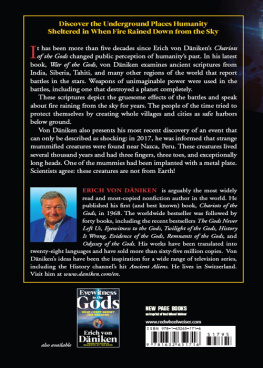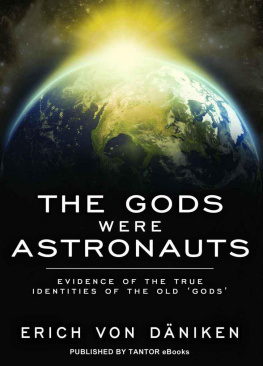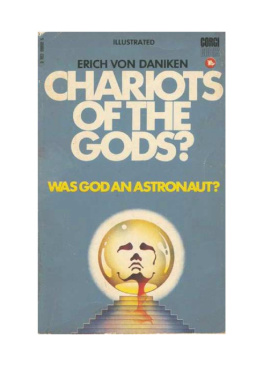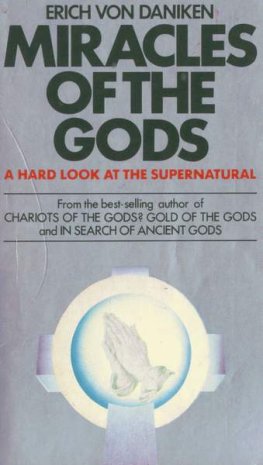Erich von Daniken - Arrival of the Gods: Revealing the Alien Landing Sites of Nazca
Here you can read online Erich von Daniken - Arrival of the Gods: Revealing the Alien Landing Sites of Nazca full text of the book (entire story) in english for free. Download pdf and epub, get meaning, cover and reviews about this ebook. year: 2011, publisher: Tantor eBooks, genre: Art. Description of the work, (preface) as well as reviews are available. Best literature library LitArk.com created for fans of good reading and offers a wide selection of genres:
Romance novel
Science fiction
Adventure
Detective
Science
History
Home and family
Prose
Art
Politics
Computer
Non-fiction
Religion
Business
Children
Humor
Choose a favorite category and find really read worthwhile books. Enjoy immersion in the world of imagination, feel the emotions of the characters or learn something new for yourself, make an fascinating discovery.
- Book:Arrival of the Gods: Revealing the Alien Landing Sites of Nazca
- Author:
- Publisher:Tantor eBooks
- Genre:
- Year:2011
- Rating:5 / 5
- Favourites:Add to favourites
- Your mark:
- 100
- 1
- 2
- 3
- 4
- 5
Arrival of the Gods: Revealing the Alien Landing Sites of Nazca: summary, description and annotation
We offer to read an annotation, description, summary or preface (depends on what the author of the book "Arrival of the Gods: Revealing the Alien Landing Sites of Nazca" wrote himself). If you haven't found the necessary information about the book — write in the comments, we will try to find it.
Erich von Daniken returns to the location of his greatest success-the plains of Nazca, where he flies over the strangest of archaeological mysteries and comes up with a new and totally surprising solution.
Arrival of the Gods: Revealing the Alien Landing Sites of Nazca — read online for free the complete book (whole text) full work
Below is the text of the book, divided by pages. System saving the place of the last page read, allows you to conveniently read the book "Arrival of the Gods: Revealing the Alien Landing Sites of Nazca" online for free, without having to search again every time where you left off. Put a bookmark, and you can go to the page where you finished reading at any time.
Font size:
Interval:
Bookmark:
Revealing the Alien Landing Sites of Nazca
By Erich von Dniken
Copyright 2011 by Erich von Dniken.
This electronic format is published by Tantor eBooks, a division of Tantor Media, Incorporated,
and was produced in the year 2011.
NAZCA? What about it? We don't need to hear any more about that, do we?
Until a few years ago, I---like many others---thought I knew almost all there was to know about Nazca. I'm fully versed in all the specialist and popular literature on the subject, in all the theories and speculations. In the last 30 years I've been to Nazca countless times. I've spent weeks flying over the surrounding desert and the near hills, and at the beginning of the seventies I hiked and stumbled for days across the hot scree and the rust-brown stone. I thought I'd put my finger on the riddle of Nazca, but in the meantime it has dawned on me just how little I and everyone else actually know.
What on earth is Nazca? Above all it is mysterious and strange, even uncanny. Nazca is at the same time both understandable and opaque. It is magic, seductive, logical and absurd all at once. Nazca is like a thunderous assault on one's reason. Its message is veiled and confused---every single theory about it is contradictory. Nazca seems unfathomable and insoluble, crazy and senseless. Some of the 'scrape drawings', the visual messages surrounding the little town of Nazca, seem childish, the result of unthinking impulse; others seem to be appealing to our powers of reason, asking us to tease out the threads of this mystery and dig down to the truth.
Nazca has so far eluded the cleverest attempts to solve its riddle. This is perhaps not surprising, given the obstinate way human reason clings to what it already knows. In an almost obsessional way we transpose our ways of thinking and our knowledge onto people who lived long ago, and whose view of the world was quite different from ours. We believe our sharp, Sherlock Holmesian cunning, our scientific methodology, will lead us inevitably to the Holy Grail of knowledge. Or we follow a different, parapsychological route, and try to 'intuit' the truth about Nazca through some kind of supersensory perception, becoming dogmatic in the process: those who don't believe such 'truths' are almost guilty, it seems, of venal sin. So we have Nazca theories, Nazca speculations, Nazca dogmas, Nazca cloud-cuckooisms, and a host of other crazy commentaries about Nazca, which all, in the end, lead nowhere.
Nazca is gigantic---and I don't just mean its geographical dimensions. Like the Great Pyramid in Egypt, Nazca is a time machine that can transport us back to the past. Whoever grasps its significance gains a perspective of phenomenal depth, at the heart of which a mirror gleams and radiates light back up to the universe.
ONCE upon a time, over the hills and far away in Peru, there was a run-down, sleepy little village. It was linked to the great capital city of Lima only by a dust-road that no one travelled unless they absolutely had to, for it passed for hundreds of kilometres through an unrelenting desert of sand and boulders. Uphill, downhill, a curve here and there, and at last a short, perilous stretch of winding mountain pass. Every two hours or so one passed a tumbledown Indian village---always at a place where streams from the far Andes ran through on their way to the Pacific Ocean. At improvised stalls the Indians offered small, dark yellow bananas, oranges with tough peel, bright green lemons and home-brewed lemonades of all colours. The way of life of these villagers was modest and monotonous. Apart from fruit, they also planted carrots, potatoes, onions and cotton, and on Sundays they all gathered together in a small Catholic church.
Nowadays, half this route is a four-lane highway, the rest a broad, tarmac road. From Lima to Nazca is about 450 kilometres in a southerly direction, towards Chile via the world-famous Pan-American Highway. (Known in Europe as the Dream Road, it crosses the American continent from north to south, from Alaska to Chile.) The Indian villages along the route are still there but have grown enormously: traffic lights and one-way streets conduct the streams of traffic through townships bursting at the seams and saturated with exhaust fumes. Restaurants, petrol stations, bars and car repair workshops line the road.
Sleepy little Nazca has become a small town complete with museum, park, shops and banks. School attendance is compulsory. Hotels of varying quality compete with one another for the custom of tourists, long-distance drivers and adventurers. The streets are overhung with the usual advertising hoardings, and at the edge of town is a small aerodrome with a tower and bar. Between 100 and 150 US dollars buys Nazca addicts a flight over the world-famous Pampa de Nazca, and a good chance of throwing up as the pilots force their small machines out of one tight curve into another. After each half-hour excursion, every tourist receives a certificate from Aero Condor, signed and dated by the pilot, stating that he or she has flown over the Nazca plain.
And yet none of these hurried travelers gets a glimpse of the real riddle of Nazca. Why is that? The tourist flights concentrate mainly on the so-called 'scrape drawings' on the rust-brown surface of the desert. These depict such things as a giant spider, a hummingbird, a monkey, a spiral and a fish---all interspersed with ruler-straight, narrow lines---and, on the slopes, various heads with rays radiating from them. There are also, finally, isolated markings on the ground which look like giant runways. All this can be observed only from an aeroplane. At ground level there is almost nothing to be seen.
I asked the chief pilot of Aero Condor, Eduardo Herran, why the tourists don't get to see the Ingenio valley and the mountains.
'We were advised to fly mainly over the scrape drawings, because these would be of interest to the tourists. The flights would also get too expensive if we were to buzz about all over the place for hours on end.'
I buzzed about all over the place---for days on end.
In the spring of 1927, the Peruvian archaeologist Toribio Mejia Xesspe was working in a small side valley of the Rio de Nazca, where there were some pre-Inca ruins. As he climbed further up the slope, where he expected to find other such remains, he stopped to get his breath back and looked down upon the Pampa de Chiquerillo, the Pampa de los Chinos, and the Pampa de Nazca. Something seemed strange. In the black-brown desert below him he made out brighter, ruler-straight lines. But he did not think much more about them, assuming they were probably ancient, pre-Columbian trails. Not until 1940, after walking along two of the lines, did Toribio Mejia Xesspe write an article about his discoveries. This was the first information to appear in print on the lines of Nazca.
On 22 June 1941, Dr Paul Kosok, historian at the Long Island University in New York, climbed aboard a single-engine plane to search for water canals between the villages of Ica and Nazca. He knew that the Incas and other tribes predating them had laid down water supply channels; these however always vanished from view at some point or other. He was hoping he would be able to pinpoint the ancient conduits more easily from the air. He had also known for two years that down there on the plain, somewhere between the Ingenio stream and the village of Nazca, lay strange lines that seemed to have been scraped out of the ground. He wondered whether the lines had anything to do with the water supply system.
Font size:
Interval:
Bookmark:
Similar books «Arrival of the Gods: Revealing the Alien Landing Sites of Nazca»
Look at similar books to Arrival of the Gods: Revealing the Alien Landing Sites of Nazca. We have selected literature similar in name and meaning in the hope of providing readers with more options to find new, interesting, not yet read works.
Discussion, reviews of the book Arrival of the Gods: Revealing the Alien Landing Sites of Nazca and just readers' own opinions. Leave your comments, write what you think about the work, its meaning or the main characters. Specify what exactly you liked and what you didn't like, and why you think so.


